| Queen Square and Lich Gates were once known as High
Green, often called the Market Place. It was renamed
after Queen Victoria's visit in 1866 when the statue of
Prince Albert was unveiled. Lich Gates contained some
interesting old buildings that were replaced with
Barclays Bank, which was built in two parts. The rear
part, built in 1876, replaced a
fine Georgian building with shop fronts and some
interesting looking windows in the roof. In 1881 the
other buildings disappeared when Lichfield Street was
straightened and widened and Barclays bank was extended
to the newly widened street. As a result the eastern
side of Lich Gates was shortened by roughly six metres. |
|
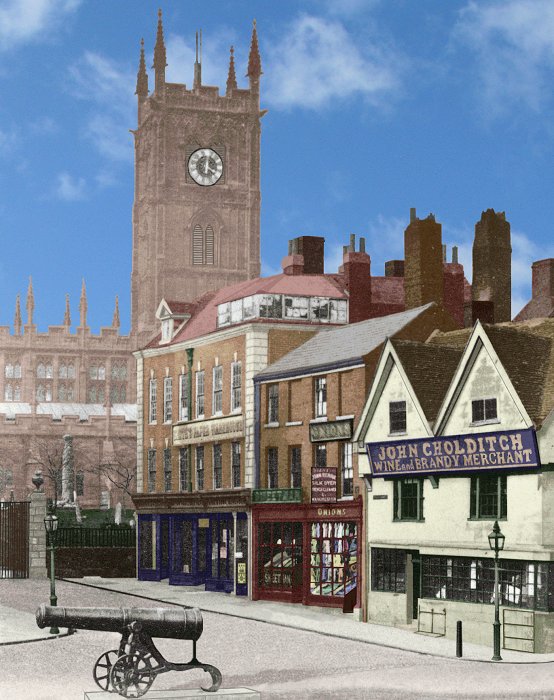
How Lich Gates may have looked in
the mid 19th century. The Russian cannon in the
foreground was captured at Sebastopol during the Crimean
War. It stood in High Green until 1866 when it was moved
to Snow Hill to make way for the statue of Prince
Albert. |
In the early 1850s the buildings on the eastern side
of Lich Gates were as follows: Nearest to St. Peter’s
Church was a large Georgian building, used as a paper
warehouse by John B. Nicklin & Company, paper merchants.
Next door was Sweetman's shop, followed by James
Onions shop. He was a hosier, glover, laceman, silk dyer
and clothes cleaner.
At the end of the street was a fine, possibly
seventeenth century building, occupied by John Cholditch,
a wine and spirit merchant. |
|
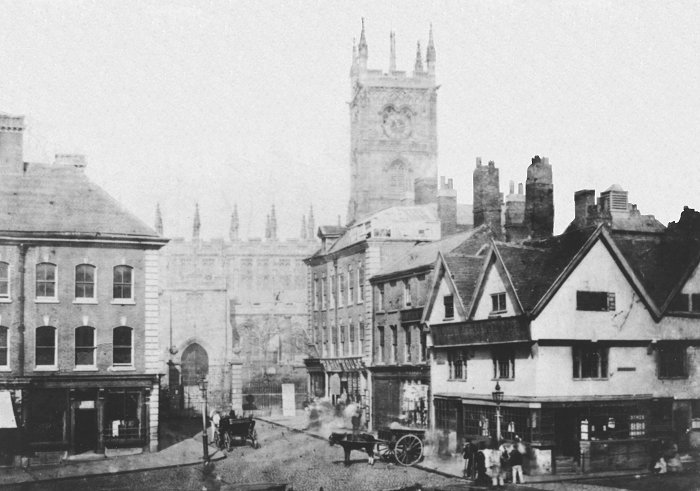
The view across High Green in the
mid 1850s, which must be one of the earliest photos
taken in the town centre. |
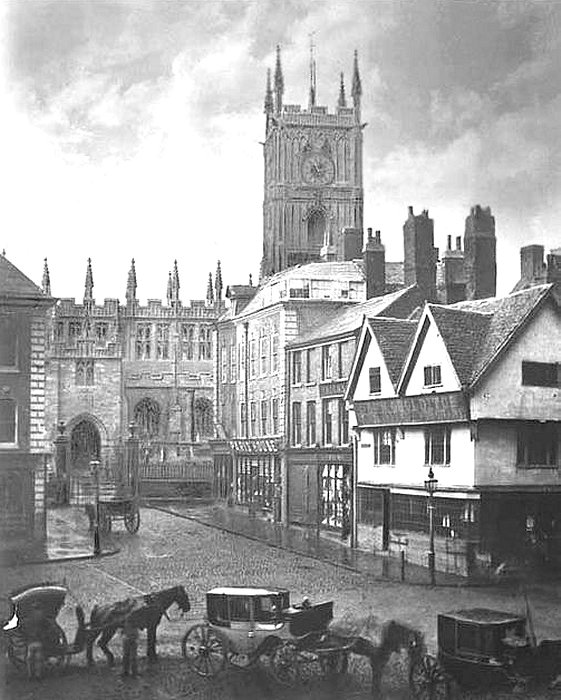 |
Another view taken between 1866 and 1881 with a row
of cabs in the foreground, waiting for passengers. By
this time the shops were as follows:
A shop belonging to W. Thomas, Paris House, a telegraph
station, Onions shop and Cholditch's. |
|
John Cholditch's wine and
brandy business, founded in 1802, was known locally
as Cholditch's. His premises had been previously
occupied by T. Bevan, who sold brandy.
John Cholditch was in partnership with J.
Barter until the 3rd October, 1844 when the
partnership was dissolved.
John Cholditch was a
churchwarden, who became councillor for the High
Green Ward in 1848. He owned the business premises
and lived in Somerford cottage, Coven. |
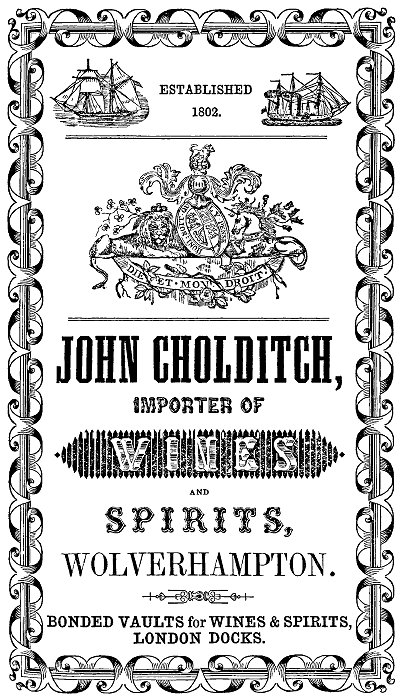
From Melville & Company's 1851 Wolverhampton
Directory.
|
|
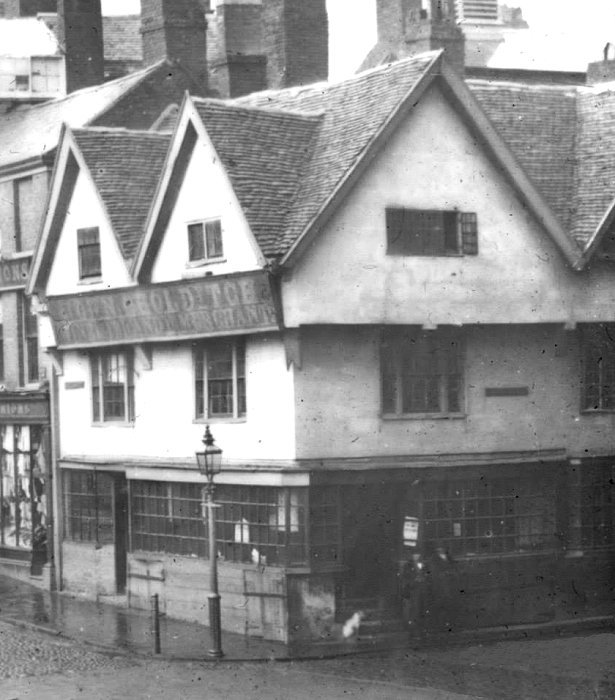
Cholditch's shop. |
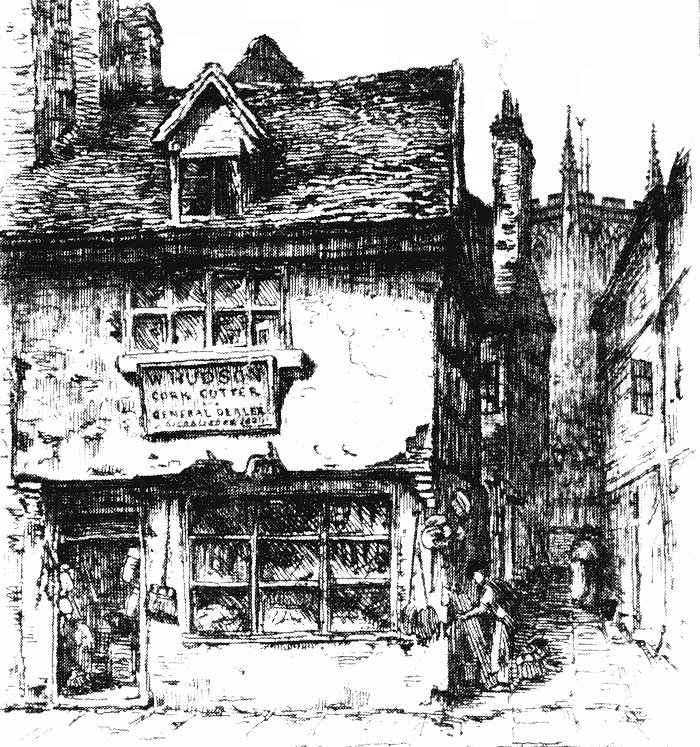
W. Hudson's cork cutting and general dealers shop
was on the northern side of Lichfield Street, on the
corner of a small alley that ran alongside John Cholditch's
wine merchant's shop and led up to the graveyard. It
was demolished in the early 1880s when the street
was redeveloped and initially occupied a shop in
Bilston Street, before moving to Victoria Street. |
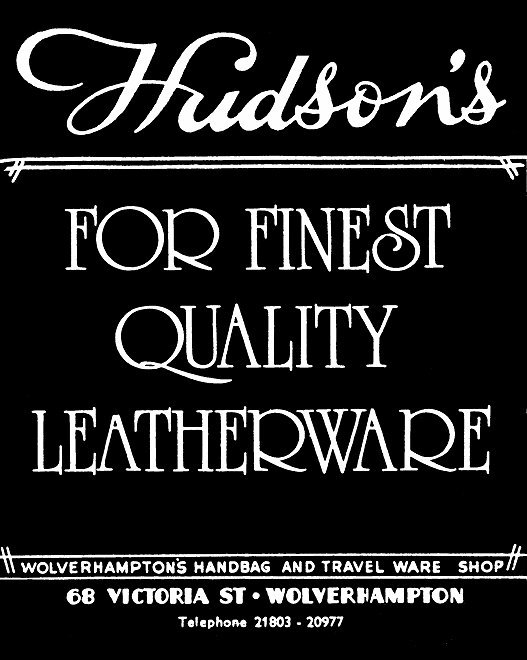 |
An advert for Hudson's
shop in Victoria Street, where it was for many
years. |
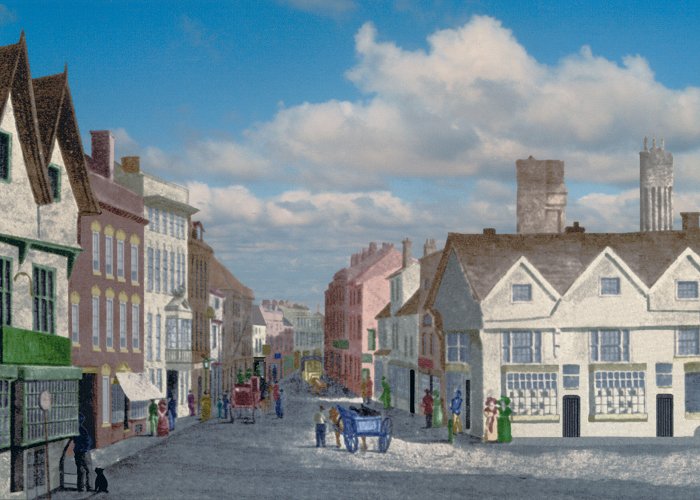
The view from what is now Lich
Gates looking towards Dudley Street with the narrow
Lichfield Street going off to the left. Based on Robert
Noyes painting from 1835. |
| On the opposite corner of Lich gates and Queen
Square was another equally well known wine and spirits
merchant,
George Cope, whose business survived until the mid
1950s. It traded for nearly 140 years and was known as
Copes Wine Lodge. The fine Georgian
house may have been built by William Pershouse, who
owned property in the area. He was a local man, but
little is known about him. A Mrs Pershouse still
occupied one of the buildings for sometime. This listed
in the Rate Book of 1777.
George Cope's fine building carries
the initials ‘W.P.’ (in
reverse) and the date 1726 which are both displayed on the
rainwater head in Lich Gates. It was built as an elegant
frontage to the old timber-framed building at the back.
In about 1755 the building was extended along Lich Gates
to add another elegant facade to the half-timbered
building. A blocked doorway can clearly be seen
in the brickwork in Lich Gates, it was possibly the site
of the handsome porch that is shown in some editions of
Bridgen's Wolverhampton Directory.
In February 1727 the building was
leased by John Fowler, Mercer and Sampson Nocke, who had
a lease for 21 years. During that time, Joseph Perkins
had a shop in the block with a wine cellar below.
By 1781, the main portion of the
building was owned by John Crutchley, an upholsterer and
auctioneer, then in 1788 it was owned by John Likley (or
Lickly) who sold wine and spirits.
In 1818 the property was purchased by George Cope, a
wine and spirits merchant. It became known as Copes Wine
Lodge. |
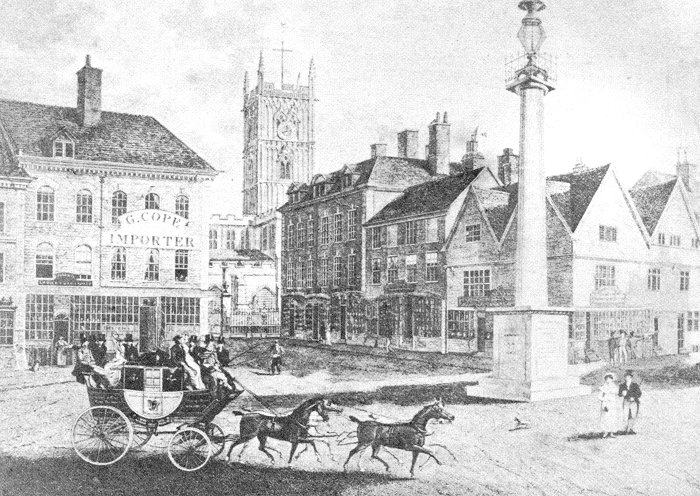
An early view of George Cope's
premises from 1821 to 1840 when the cast iron column
with the gas lantern stood in High Green. From The Book
of Wolverhampton by Frank Mason. |
|
In 1851 George Cope is listed as a
wine and spirit merchant in Wolverhampton Market place,
with a shop in Church Street, Bilston. He lived at The
Lodge, Tettenhall Wood.
In Kelly's 1912 Directory the
business is listed as George Cope & Son, wine & spirit
merchants, 44 Queen Square.
In the 1908 Wolverhampton Red Book
it is listed as T. B. Cope, wine and spirit merchant,
Queen Square.
Thomas Berwick Cope was George
Cope's son who also lived at The Lodge.
The 1881 census lists Thomas B.
Cope, aged 40, his wife Mary A. Cope, aged 39 and George
B. Cope, aged 10. They had 3 servants, two were
housemaids and one was a cook.
Next to the half-timbered building
behind the Georgian frontage was a small courtyard that
was accessed by a narrow alleyway called Bird in Hand
Yard. At the back were two pubs, the Bird in Hand and
the Golden Ball. In 1851 a consortium of 10 local men,
entered into an agreement with the Borough Council for
the improvement of this part of town. As a result the
Bird in Hand Yard was widened and straightened and
carried through to Cheapside to become Exchange Street. |

From Harrrison, Harrod & Company's
Directory and Gazetteer, 1861. |
| In the course of the work, the Golden Ball and the
Bird in Hand were demolished and the building now known
as St. Peter's House was built on the site. It was
purchased by George Cope in April 1852. He seems to have used
the cellars and ground floor for this business and let
other parts to the London and North Western Railway
Company and the Athenaeum Assurance Company. In 1854 he
leased the whole of the building to Norris's Patent Chair
Company. By 1919 a butcher's shop had been established
in the northern half of the building, the other half
being used as a wine merchant's
shop. The whole of the Exchange Street ground floor
frontage was changed into shop fronts. Wolverhampton
Council acquired the premises in 1920 and used the upper
floor as offices, then in 1974 the property was
transferred to St. Peter's Church in exchange for the
site of the old St. Peter's Schools, needed for the
Polytechnic. It is now used as a church centre and a
cafe.
The building in the north eastern corner of the site,
known as The Old Bank Chambers, which has been occupied
by Thornes Solicitors for many, many years, was built in
the late 18th century and was also acquired by George
Cope and used for part of his business.
|
|
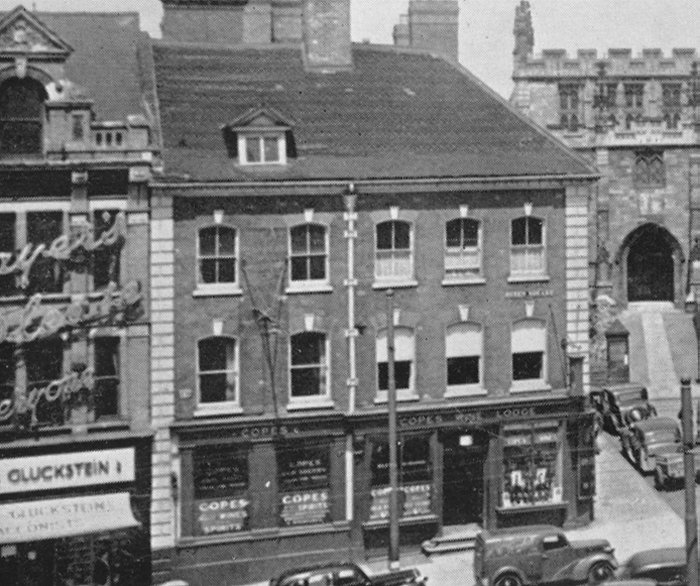
Cope's Wine Lodge in about 1940. |
| In 1954 a Mr. and Mrs. Hemmings bought the courtyard
and built a small, single storey shop there, which
became famous for the sale of crockery. The shop
remained there until the late 1970s when the council
acquired and renovated the half-timbered building. Cope's Wine Lodge closed in 1955 and the buildings
fronting Queen Square became Queen Square Carpets on the
corner of Exchange Street, J. W. Wassall's shoe shop;
and Joan's fashion shop on the corner of Lich Gates.
When Joan's fashion shop closed, the old Copes Wine
Lodge became a branch of the South Staffordshire
Building Society, then a branch of Nationwide Building
Society. At the moment (early 2021) the shop is empty. |
 |
Return to
the menu |
|